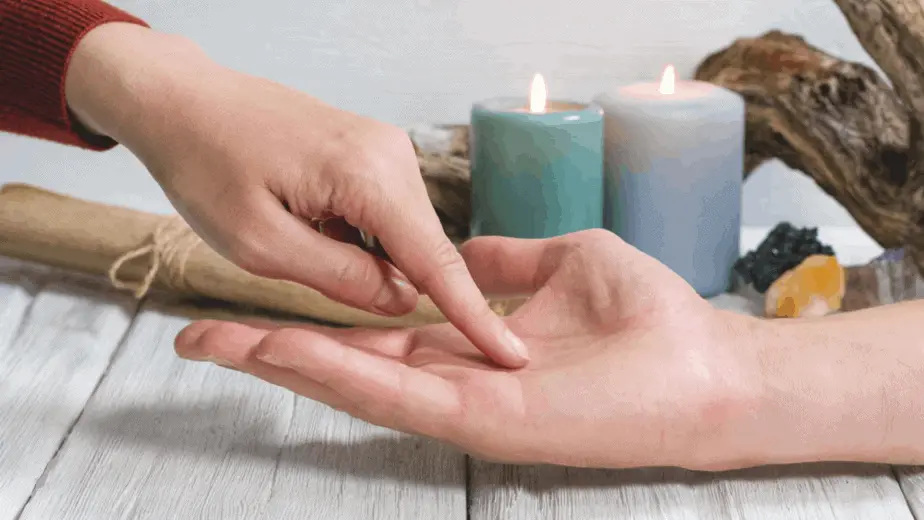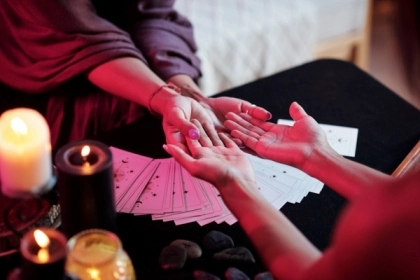Palmistry, also known as chiromancy or palm reading, is an ancient practice that involves interpreting the lines, shapes, and other features of a person’s hand to gain insight into their character traits, personality, potential future events, and even their health. It has been a part of various cultures and traditions for centuries, and while some consider it a form of divination or pseudoscience, others see it as a tool for self-discovery and personal reflection.
The significance and use of palmistry can be understood from different perspectives:

Self-awareness and introspection: For some individuals, palmistry serves as a means of self-exploration. By analyzing the lines and features of their hands, they believe they can gain a deeper understanding of their strengths, weaknesses, and innate qualities. This can lead to increased self-awareness and potentially aid in personal development.
Entertainment and social purposes: Palmistry is often used for entertainment purposes at events, parties, and fairs. People may find it fun and intriguing to have their palms read and receive general insights about their lives. It can also be a conversation starter and a way to bond with others.
Cultural and traditional significance: In various cultures, palmistry is considered a significant art form and is often passed down through generations. It is deeply rooted in cultural beliefs and practices and may be used for various purposes like matchmaking, predicting auspicious times, and making important life decisions.
Psychological effect: The process of having one’s palm read can have a psychological impact on the individual. The act of discussing personal matters with the palm reader may lead to a cathartic effect or a sense of relief.
Potential guidance: Some people turn to palmistry as a form of guidance for making decisions or understanding potential life paths. However, it is essential to approach palmistry with a critical mindset and not solely rely on it for life-changing choices.

The history of palmistry can be traced back to ancient civilizations and is believed to have originated in India, China, and ancient Sumeria. It has been practiced and developed over thousands of years, spreading to various cultures and regions. Here is a brief overview of the history of palmistry:
Ancient India: Palmistry, known as “Hast Jyotish” or “Hasta Samudrik Shastra” in Sanskrit, has its roots in ancient Indian texts. Indian sages and seers were among the first to study and codify the principles of palmistry. The ancient Indian texts such as the “Hasta Samudrika Shastra” and the “Bhrigu Samhita” are considered early references to palmistry and its interpretations.
Ancient China: Palmistry also has a long history in China, where it is referred to as “Cheiromancy.” The Chinese believed that the hands reflect a person’s energy flow and that the lines on the palm can provide valuable insights into one’s life and personality.
Ancient Egypt: The ancient Egyptians were known to practice a form of hand analysis. They believed that the hands contained secrets about an individual’s life, and palmistry was used in conjunction with other forms of divination.
Ancient Greece and Rome: Palmistry gained popularity in ancient Greece and Rome. Aristotle, the Greek philosopher, wrote about palmistry and its significance. The Greek physician Galen also practiced chiromancy and used it as a diagnostic tool for understanding health conditions.
Middle Ages: During the Middle Ages, palmistry spread across Europe through trade and cultural exchange. It became integrated into various traditions and was practiced alongside other forms of divination.
Renaissance Period: Palmistry experienced a resurgence during the Renaissance. Scholars and mystics explored the art of palmistry and contributed to its development and popularity.
19th and 20th Centuries: In the 19th and 20th centuries, palmistry gained widespread attention and became a popular subject for books and publications. Notable palmists like Cheiro (Count Louis Hamon) and William G. Benham played significant roles in popularizing palmistry during this period.
Throughout its history, palmistry has undergone various interpretations and modifications, depending on cultural beliefs and practices. Different cultures have assigned different meanings to the lines, mounts, and shapes of the hands. While the practice of palmistry has persisted over the centuries.
Palmistry involves interpreting various lines, mounts, shapes, and other features on the palm to gain insights into a person’s personality, traits, and potential life events. Common lines include the heart line, head line, life line, and fate line, among others. Mounts represent different aspects of an individual’s character.
In palmistry, the lines on the hand are believed to provide insights into a person’s character, personality traits, potential life events, and even health. Here are some of the key lines in palmistry and their general interpretations:
Heart Line: The heart line, also known as the love line, is located just below the fingers and runs horizontally across the top of the palm. It is associated with emotions, love, relationships, and how a person expresses and receives affection. A deep and clear heart line is said to indicate a warm and passionate nature, while a wavy or poorly defined line might suggest emotional complexities.
Head Line: The head line starts from the base of the palm, between the thumb and index finger, and runs horizontally across the palm. It represents a person’s intellectual abilities, communication style, and decision-making process. A long, straight head line suggests clear thinking and a logical approach, while a short or curvy line might indicate creativity and spontaneity.
Life Line: The life line, often the most prominent line, curves around the base of the thumb and follows an arc towards the wrist. Contrary to popular belief, it does not predict the length of life but is associated with vitality, energy levels, and overall well-being. A deep and well-defined life line is thought to indicate robust health, while a faint or fragmented line might suggest a more delicate constitution.
Fate Line (Career Line): The fate line is vertical and runs from the base of the palm up toward the middle finger. It is linked to career and life path, indicating the person’s achievements, successes, and changes in professional life. A strong fate line suggests a clear sense of direction and drive, while a weak or interrupted line may imply a more unpredictable career path.
Sun Line (Apollo Line): The sun line runs parallel to the fate line and is associated with success, creativity, and fame. Not everyone has a sun line, but if present, it is thought to enhance the qualities of the fate line.
Mercury Line (Health Line): The mercury line, also known as the health line, runs parallel to the lifeline. It is believed to reflect a person’s health and well-being. A strong and clear mercury line suggests good health and vitality, while a broken or weak line might indicate potential health issues.
In addition to the main lines (heart line, head line, life line, fate line, and mercury line), palmistry involves interpreting other lines, markings, and objects on the palm. These secondary lines and objects can provide further insights into a person’s character, potential events, and life circumstances. Here are some of the other lines and objects in palmistry:
Marriage Line (Union Line): The marriage line, located below the little finger, is believed to indicate relationships, marriage, and significant partnerships. The number, length, and appearance of these lines can offer clues about the timing and nature of romantic relationships.
Children Lines: These lines are vertically oriented and may appear above the marriage line. They are thought to represent the number of children a person may have and their general well-being.
Girdle of Venus: This curved line runs parallel to the heart line and is associated with emotions, sensitivity, and creativity. A prominent girdle of Venus may suggest heightened emotional sensitivity.
Travel Lines: These horizontal lines, located on the lower area of the palm, are believed to indicate travel opportunities or relocations.
Intuition Line: Also known as the Apollo line, it is a vertical line rising from the upper part of the mount of the moon and is thought to signify an individual’s intuition, creative talents, and psychic abilities.
Mounts: Palmistry also considers the palm’s various mounts or fleshy areas. Each mount is associated with different personality traits. For example, the mount of Venus is linked to love and sensuality, Jupiter to ambition and leadership, and Mercury to communication skills.
Crosses: These are intersection points of lines that may indicate significant events or challenges in a person’s life.
Islands: Islands are small, separated areas on a line, suggesting obstacles or periods of difficulty in the associated area of life.
Triangles: Triangles formed by the intersection of lines are considered positive and fortunate symbols, indicating success or protection.
Stars: Stars on the palm are believed to represent favorable events or exceptional talents.
Grilles: Grilles are a series of intersecting lines, indicating potential obstacles or struggles.
Conclusion
In conclusion, the significance of palmistry lies in its historical, cultural, and psychological aspects. While it can be an interesting tool for self-reflection and entertainment, individuals should approach it with an open mind and not use it as the sole basis for important life decisions. For more substantial matters, seeking advice from trained professionals in relevant fields is always recommended.







